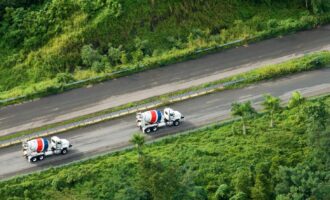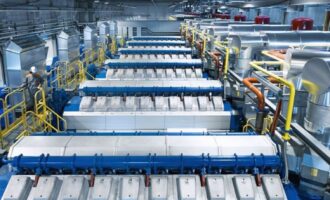Caltex pumps up customer choice with CNG
Motorists and transport companies keen to explore alternative fuels have been given something new to think about with the launch of a public Compressed Natural Gas (CNG) refuelling facility by Caltex Australia.
Partnering with AGL Energy Limited (AGL), Caltex will bring CNG to its Star Mart site at Tullamarine, leading the charge as the first major fuel supplier in Australia to offer this niche fuel on a service station site.
The facility, opened today by Caltex’s Executive General Manager Commercial, Bruce Rosengarten, is expected to mainly service commercial truck fleets already operating with the fuel. However, Mr Rosengarten said the fuel would also be sold to other motorists if their vehicle was compatible.
“While commercial trucks, buses and machinery represent the vast majority of the 3000 existing CNG vehicles operating nationally, building this type of refuelling infrastructure will give motorists with compatible vehicles access to the niche fuel too,” Mr Rosengarten said.
“There is a growing trend toward natural gas with more than 13 million vehicles powered by the fuel globally.
“In Australia a major barrier is the lack of new vehicles designed to use the fuel and, as a result, there has not been demand for refuelling facilities.
“By opening the Tullamarine CNG facility, Caltex and AGL will ensure the alternative fuel is available to motorists if and when it is needed, while meeting the needs of existing commercial customers.”
AGL Executive General Manager New Energy Marc England said that AGL was very pleased to be working with Caltex on this initiative.
“This partnership can help businesses focus on cost effectiveness and enable them to reduce their environmental footprints, so we believe it is a smart choice for fleet companies,” Mr. England said. The opening was attended by Mr Josh Bull MP, State Member for Sunbury.
Caltex Australia
With a commitment to Australia tracing back to 1900, Caltex has grown to become the nation’s outright leader in transport fuel. Caltex supplies one-third of all Australia’s transport fuels and is unique in this market for being the only major brand listed on the Australian Securities Exchange. Through its comprehensive supply chain, Caltex has forged its reputation for providing safe and reliable supply of high-quality fuels to a diverse number of customer segments, including retail, mining, agriculture, aviation, transport, small-to-medium enterprises, marine, automotive and government. Caltex is also one of Australia’s largest convenience retailers and franchisors, with over 85% of its stores operated by franchisees.
Caltex media contact
Allison Gumbleton
Media & Communications Advisor
P: (02) 9250 5294
E: [email protected]
FAQs
What is Compressed Natural Gas (CNG)?
CNG is natural gas that has been compressed for vehicle use. CNG remains as a gas, not a liquid like LPG. Natural gas can also be liquefied at about minus 160 degrees to form liquefied natural gas or LNG.
Are CNG and LPG the same?
CNG and LPG are not the same. CNG is made up primarily of naturally occurring methane and is used in homes, restaurants and factories for cooking and heating. LPG is made from a mixture of propane and methane.
What are the benefits of CNG?
Lower running costs, reduced emissions and potentially more stable pricing.
How is CNG sold?
CNG is sold in kilograms. The pump will display a price per kilogram.
How many CNG vehicles are there in Australia?
There are more than 3000 CNG vehicle in Australia, made up of buses, machinery, commercial trucks and a small number of passenger vehicles. There are estimated to be more than 13 million natural gas vehicles globally, with the majority powered by CNG.
What types of CNG vehicles are available?
There are three types of CNG vehicles: a vehicle which only runs on CNG; dual fuel vehicles where it can run on either CNG or petrol; and dual-vehicle (limited to heavy-duty applications) where the engine runs on CNG but uses diesel fuel for ignition assistance.
How does CNG fuel-range compare with other fuel products?
Fuel economy depends on many variables including the type of vehicle, tank capacity and the way it is driven. A single fuel CNG vehicle (i.e.one tank, no petrol or diesel) will typically have a reduced range due to lower density of gas compared to liquid fuels.
Where will CNG be located at the Tullamarine site?
CNG is available to all customers, provided their vehicle is compatible. It will be available in the diesel refuelling area alongside diesel, Vortex Diesel and AdBlue (a non-fuel product).
What are the growth prospects of CNG in Australia?
Like any fuel product, the future prospects of CNG will be dependent on the economics relative to other fuel options. Caltex will continue to provide a broad range of fuel products where and when customers need them. Our focus will always be on our customers. Our strategy is to work alongside them to provide whatever fuels they require.
Is CNG taxed?
CNG attracts both excise and GST.
What will the pump price be?
The approximate pump price will be $1.60 per kilo of CNG and will vary based on the market and changes to cost price and taxes
How does CNG compare to diesel?
One kilogram of CNG is equivalent to approximately 1.4 litres of diesel
Where can I find more information about CNG?
http://www.agl.com.au/business/agl‐energy‐services/alternative‐fuels/cng









